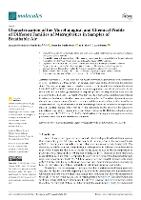Resumen
Microplastic (MP) contamination has become a problem of great interest to the community at large. The detection of these particles in different ecosystems and foods has been the subject of study. However, the focus of these investigations has been on the identification and quantification of PM by DSC and Pyr-GC/MS and not on how they are transported to reach the air we breathe. In this study, the values of morphological parameters for plastic particles in a range between 1 and 2000 µm, present in the breathable air of 20 neighborhoods in the city of Cartagena, Colombia, were obtained to determine the characteristics that make these particles airborne. The values of parameters were obtained, such as roundness, sphericity, curvature, and the convexity of the particle, as well as its compactness and size, which influence its transport through the air and its ability to be ingested and inhaled. The data obtained in this study allows for simulations and the analysis of the behavior of microplastics once in the environment to predict future settlements. The DSC showed us the melting temperatures of PP, PE, PET, and PS, the Pyr-GC/MS showed the fragmentation patterns, and the presence of these MPs in the samples was confirmed.














